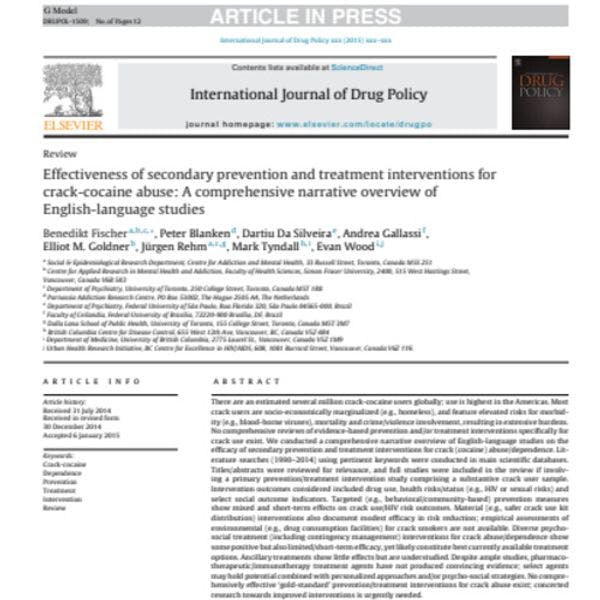Effectiveness of secondary prevention and treatment interventions for crack-cocaine abuse: A comprehensive narrative overview of English-language studies
There are an estimated several million crack-cocaine users globally; use is highest in the Americas. Most crack users are socio-economically marginalized (e.g., homeless), and feature elevated risks for morbid- ity (e.g., blood-borne viruses), mortality and crime/violence involvement, resulting in extensive burdens. No comprehensive reviews of evidence-based prevention and/or treatment interventions specifically for crack use exist. We conducted a comprehensive narrative overview of English-language studies on the efficacy of secondary prevention and treatment interventions for crack (cocaine) abuse/dependence. Lit- erature searches (1990–2014) using pertinent keywords were conducted in main scientific databases. Titles/abstracts were reviewed for relevance, and full studies were included in the review if involv- ing a primary prevention/treatment intervention study comprising a substantive crack user sample. Intervention outcomes considered included drug use, health risks/status (e.g., HIV or sexual risks) and select social outcome indicators.
Targeted (e.g., behavioral/community-based) prevention measures show mixed and short-term effects on crack use/HIV risk outcomes. Material (e.g., safer crack use kit distribution) interventions also document modest efficacy in risk reduction; empirical assessments of environmental (e.g., drug consumption facilities) for crack smokers are not available. Diverse psycho- social treatment (including contingency management) interventions for crack abuse/dependence show some positive but also limited/short-term efficacy, yet likely constitute best currently available treatment options. Ancillary treatments show little effects but are understudied. Despite ample studies, pharmaco- therapeutic/immunotherapy treatment agents have not produced convincing evidence; select agents may hold potential combined with personalized approaches and/or psycho-social strategies. No comprehensively effective ‘gold-standard’ prevention/treatment interventions for crack abuse exist; concerted research towards improved interventions is urgently needed.
Keep up-to-date with drug policy developments by subscribing to the IDPC Monthly Alert.
Downloads
Regions
Related Profiles
- International Journal of Drug Policy
